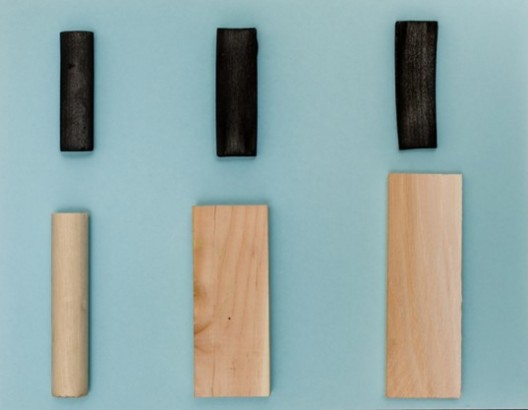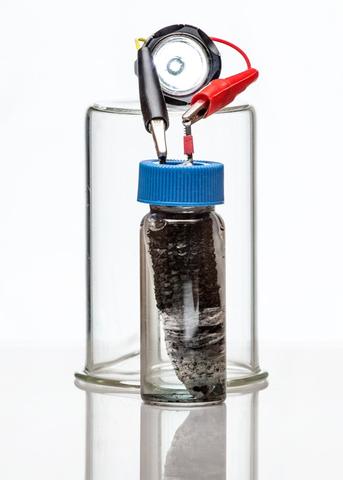Researchers at the Illinois Sustainable Technology Center at the University of Illinois report, “that wood-biochar supercapacitors can produce as much power as today’s activated-carbon supercapacitors at a fraction of the cost – and with environmentally friendly byproducts.”
Junhua Jiang, senior research engineer at the Center, has been reducing wood and cellulose products such as corncobs to biochar by heating the fibers in a reduced oxygen environment. This pyrolysis process creates a porous, black substance that can be used as electrodes in supercapacitors. While other researchers use carbon black or more advanced forms of carbon such as nanotubes, this more humble approach yields equal or better performance at a fraction of the cost of the more labor-intensive methods. Many of the alternatives obtain their carbon from fossil-fuels, making biochar the environmental option.
Jiang notes, “Supercapacitors are ideal for applications needing instant power and can even provide constant power – like batteries, but at lower cost,” adding that they are useful in transportation, electronics and solar- and wind-power energy storage and distribution.
Most carbon exploitation involves “costly and complicated procedures” to grow a pore network and increase the surface area on the electrode. This helps it capture and release energy quickly. The biochar method eliminates a great deal of the complications. Wood already has a nice pore structure that stays in place when burnt, especially in low-oxygen surroundings.
Biochar reduces or eliminates the toxic chemicals used in processing other carbon electrodes. The team washed impurities such as calcium carbonate and potassium carbonate from their biochar with mild nitric acid. The resulting solution can be used as fertilizer.

Researchers note that “Any kind of wood can be made into biochar by heating in a low-oxygen chamber. Some types of wood work better than others.” Left to right, white birch, white pine and red cedar. | Photo by L. Brian Stauffer
Icing the cake, “The material costs of producing wood-biochar supercapacitors are five to 10 times lower than those associated with activated carbon,” Jiang said.
Jiang concludes, “The performance of our biochar materials is comparable to the performance of today’s advanced carbon materials, including carbon nanotubes and graphenes. We can achieve comparable performance with much less cost and probably much lower environmental costs.”
Adding the cherry on top, when biochar supercapacitor are done producing power thousands of cycles in the future, “the electrodes can be crushed and used as an organic soil amendment that increases fertility.”
U of Illinois soil scientists report, “Biochar can be used as a fuel or as a soil amendment. When used as a soil amendment, biochar can boost soil fertility, prevent soil erosion, and improve soil quality by raising soil pH, trapping moisture, attracting more beneficial fungi and microbes, improving cation exchange capacity, and helping the soil hold nutrient. Moreover, biochar is a more stable nutrient source than compost and manure. Therefore, biochar as a soil amendment can increase crop yields, reduce the need for chemical fertilizers, and minimize the adverse environmental effects of agrochemicals on the environment.”
Biochar helps sequester the carbon that would otherwise be released into the atmosphere, according to University researchers.
“Another potentially enormous environmental benefit associated with biochar used in soil is that it can sequester atmospheric carbon. In the natural carbon cycle, plants take up CO2 from the atmosphere as they grow, and subsequently CO2 is emitted when the plant matter decomposes rapidly after the plants die. Thus, the overall natural cycle is carbon neutral. In contrast, pyrolysis can lock up this atmospheric carbon as biochar for long periods (e.g., centurial or even millennial time scales). Therefore, the biochar approach is an attractive solution to alleviating global warming concerns. James Lovelock, famous for his Gaia hypothesis, is now advocating biochar as ‘One last chance to save mankind’”.
Ashes to ashes seems like a great idea with a less than morbid outcome in this context.
The paper, “Highly Ordered Macroporous Woody Biochar With Ultra-High Carbon Content as Supercapacitor Electrodes,” is available online or from the U. of I. News Bureau.
Dr. Jiang’s presentation, “Progress of Biochar Supercapacitors,” includes several notable comparisons showing that inexpensive biochar can emulate the performance of higher-priced alternatives, including carbon black and carbon nanotubes.

